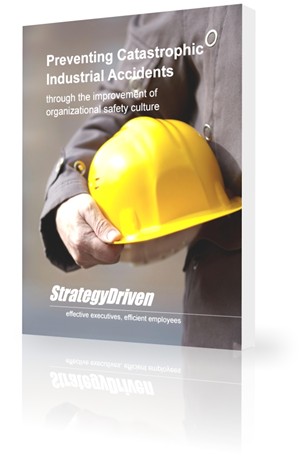StrategyDriven White Paper Advises Leaders on Preventing Catastrophic Industrial Accidents
StrategyDriven’s Preventing Catastrophic Industrial Accidents reveals how high-risk industry leaders can reduce their significant event risk exposure through application of safety-first principles.

After the several recent catastrophic industrial accidents within the United States, including the devastating explosions at a Texas fertilizer plant and Louisiana chemical plant, StrategyDriven wanted to help industrial and utility leaders reduce the risk of similar accidents at their facilities.
“Many of today’s significant industrial accidents are preventable, the byproduct of human errors made when safety was subordinated to other priorities,” explains Nathan Ives, StrategyDriven’s President and Chief Executive Officer. “By fostering an organizational culture that puts safety-first, executives and managers create a workplace environment where errors are recognized and proactively corrected before they result in a material event.”
“An effective safety culture is far more than slogans and posters,” continues Greg Gaskey, StrategyDriven’s Chief Operations Officer. “It permeates the organization’s performance standards, operating processes, training programs, rewards systems, and, most importantly, the decisions and behaviors of everyone from the C-Suite to the shop floor.”
Nathan and Greg authored Preventing Catastrophic Industrial Accidents based on their decades of experience managing nuclear and industrial complex operations. Additionally, Nathan led the development of the nuclear industry’s operational risk management, high-risk decision management, and plant operations performance standards while working at the Institute of Nuclear Power Operations.
Highlights from Preventing Catastrophic Industrial Accidents include:
- Safety Culture Attributes – safety focused executives, managers, and employees collectively assume responsibility for both their and their co-workers’ safety; embody a questioning attitude; encourage issue reporting and priority-based resolution; employ error reduction techniques; embed safety-first features within operational, training, and rewards programs; and embrace ongoing organizational learning
- Identifying the Strength of Your Safety Culture – artifacts of the safety-first values are not only found in the outcomes achieved, but also reside in the organization’s goals and performance measures, standards and expectations, policies and procedures, rewards systems, training, and organizational learning and continuous improvement programs
- Improving Your Safety Culture – individuals at all levels of the organization must be engaged in order to foster a robust safety culture; originating from executive defined attributes and goals and translated to the day-to-day decisions and actions of all employees
Preventing Catastrophic Industrial Accidents is being distributed to StrategyDriven’s clients, including some of the world’s largest utility operators. Download the white paper by clicking here.
About the Authors



 Over time, leaders can grow their performance measurement systems to include almost countless numbers of interrelated metrics. Ensuring these numerous metrics remain well aligned, their output quality and relationship integrity preserved, and their meaning well understood while continuing to be of value to executives, managers, and employees necessitates a method of inventorying the measures themselves and their underlying construction characteristics. In our experience, the optimal method for maintaining such an inventory is through the use of a centralized metrics inventory database.
Over time, leaders can grow their performance measurement systems to include almost countless numbers of interrelated metrics. Ensuring these numerous metrics remain well aligned, their output quality and relationship integrity preserved, and their meaning well understood while continuing to be of value to executives, managers, and employees necessitates a method of inventorying the measures themselves and their underlying construction characteristics. In our experience, the optimal method for maintaining such an inventory is through the use of a centralized metrics inventory database. Jeffrey Gitomer is the author of The Sales Bible, Customer Satisfaction is Worthless Customer Loyalty is Priceless, The Little Red Book of Selling, The Little Red Book of Sales Answers, The Little Black Book of Connections, The Little Gold Book of YES! Attitude, The Little Green Book of Getting Your Way, The Little Platinum Book of Cha-Ching, The Little Teal Book of Trust, The Little Book of Leadership, and Social BOOM! His website,
Jeffrey Gitomer is the author of The Sales Bible, Customer Satisfaction is Worthless Customer Loyalty is Priceless, The Little Red Book of Selling, The Little Red Book of Sales Answers, The Little Black Book of Connections, The Little Gold Book of YES! Attitude, The Little Green Book of Getting Your Way, The Little Platinum Book of Cha-Ching, The Little Teal Book of Trust, The Little Book of Leadership, and Social BOOM! His website,  Ken Lloyd, PhD, is a nationally recognized Southern California management consultant, author, speaker, and newspaper columnist. He has taught numerous MBA classes at The Anderson School at UCLA and lectures at many other universities. He is the vice president of planning and development at Strategic Partners, Inc. and a frequent television and talk-radio guest, as well. He has authored several books, including Jerks at Work and Performance Appraisals and Phrases for Dummies. A member of the American Psychological Association and the Society for Industrial and Organizational Psychology, he graduated from UC Berkeley and received his MS and PhD in organizational behavior from UCLA.
Ken Lloyd, PhD, is a nationally recognized Southern California management consultant, author, speaker, and newspaper columnist. He has taught numerous MBA classes at The Anderson School at UCLA and lectures at many other universities. He is the vice president of planning and development at Strategic Partners, Inc. and a frequent television and talk-radio guest, as well. He has authored several books, including Jerks at Work and Performance Appraisals and Phrases for Dummies. A member of the American Psychological Association and the Society for Industrial and Organizational Psychology, he graduated from UC Berkeley and received his MS and PhD in organizational behavior from UCLA. As a business leader, you face mission-critical challenges every day. Working through these important issues in a deliberate way increases your chances of making the right decisions.
As a business leader, you face mission-critical challenges every day. Working through these important issues in a deliberate way increases your chances of making the right decisions.